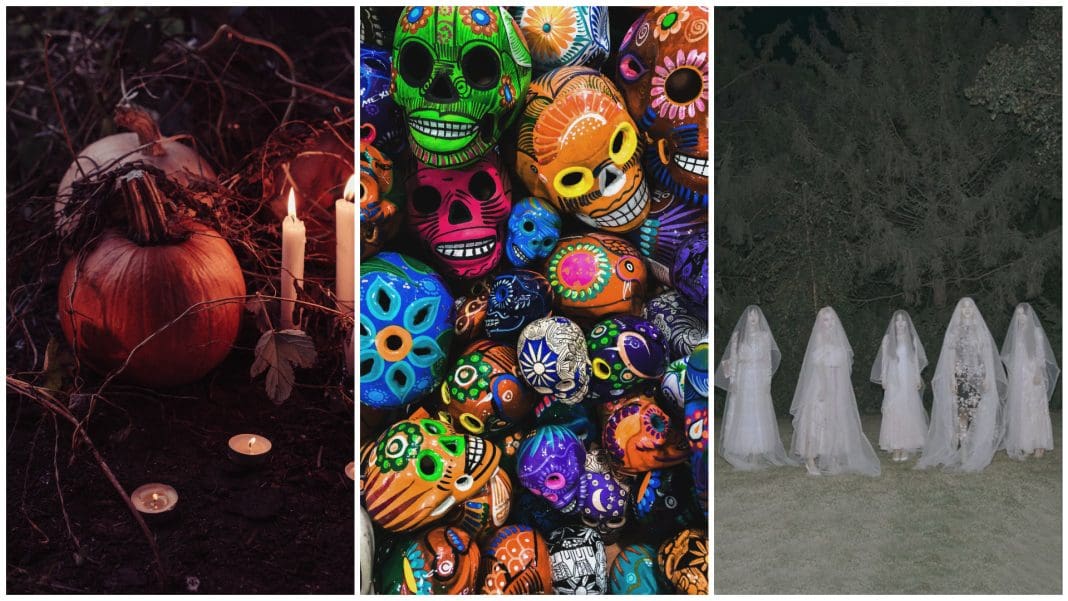With its Celtic roots, Halloween started as a pagan celebration to welcome the harvest season called Samhain /SAH-win/. At the time, people would wear costumes and gather around bonfires in order to ward off ghosts and evil spirits that might disrupt a bountiful harvest. It was adopted by the church in the eighth century when Pope Gregory III declared the 1st of November as All Saints’ Day, the day after Halloween (previously All Hallows’ Eve).
Moving forward, different cultures have adopted Halloween as well, or even just its concept in essence which reflects their respective traditions. Countries that have heavy Western influences may celebrate through costume parties and trick-or-treating. Latin American countries, on the other hand, usually focus on traditions that honor the dead because of their Catholic or Christian beliefs. Let’s go around the globe and explore how some areas celebrate Halloween!
Día de los Muertos in Latin America

Albeit not being identical to the Halloween that majority would think about when they hear the word, it is still noteworthy to talk about Día de los Muertos as it falls under the same umbrella of the theme of the dead, the supernatural, and it also falls under the same dates. After the declaration of the church for November 1st to be All Saints’ Day, Saint Odilo of Cluny declared the 2nd to be All Souls’ Day in the 11th century to honor the dead. In Latin American countries, Spain, and Mexico, they hold a three-day celebration beginning on October 31st in the belief that souls return to their respective homes during Halloween, as seen in the Disney film Coco (2017).
Coco (2017) basically sums up what it looks like in Latin countries during the holiday. Altars are put up, candles and incense lit, and the deceased are honored with flowers, food offerings, photographs, and the like. Some families celebrate by drinking, and letting bands play music.
The Legend of Sleepy Hollow in America

Early settlers in America brought the first semblance of Halloween, and because of the puritan origins of early America, parties were only introduced in modern times as they originally carved pumpkins and lit candles to ward off evil spirits, similar to the Celtic tradition.
The Halloween tradition of trick-or-treating came in the mid-1800s when Irish immigrants brought their practice of dressing up and asking neighbors for food and money. This practice included pranks, which is now referred to as “trick” if the household chooses not to give treats. Out of routine, it has been the default for people to prepare candies for trick-or-treaters.
Moving to 1820, we get to see the biggest transformation of the holiday since half a century ago. This is because of Washington Irving’s The Legend of Sleepy Hollow which focused a lot on the horror aspect of Halloween, becoming the first set of American ghost stories in relation to the holiday. This was quickly picked up by pop culture, even having its own franchise with the Hollywood cult classic, “Halloween” with the notorious Michael Myers.
The infamy of Halloween and pop culture’s involvement with its loud echoes in status quo have led to Halloween becoming a festival of parties participated by teenagers and adults. Halloween parties are being held with people wearing costumes, holding raves and drinking booze.
Halloween in the Philippines

Having been colonized by both Spain and USA, Halloween in the Philippines is a love baby of two contrasting traditions of the aforementioned countries.
While the Philippines has a really rich culture and history of folklore regarding mythical creatures like the manananggal, kapre, tikbalang, and all of the story book characters you can think of, Halloween on the ground does not necessarily focus on these creatures in certain areas of the country, especially the more urbanized ones. This is with the exception of airing movies and shows on television, however, and decorations you see in the mall. Some people in the country even condemn the parading of these scary or mythical creatures since they think that such are demonic and disrespectful to the most practiced religion, Catholicism.
This is where the influence of Spain comes in. The most common practice in the Philippines during this season is definitely All Souls’ Day and All Saints’ Day. Being a very religious country, the Philippines spends Halloween through going to church, holding masses for the dead, and going to cemeteries to visit their deceased loved ones.
On the other hand, you can see the young lean more into the Western influences of Halloween. Bars and clubs during Halloween hold parties and Halloween costume competitions while everyone drinks to their hearts’ content.

Halloween has become a huge part of everyone’s cultures, wherever you may be in the world. Its importance to the public conscience is a reflection of people’s values regarding their loved ones, their connection to their culture, and the supernatural. However you may choose to celebrate it, remember that those whom you love will always be part of you, have fun, and have a happy Halloween.

